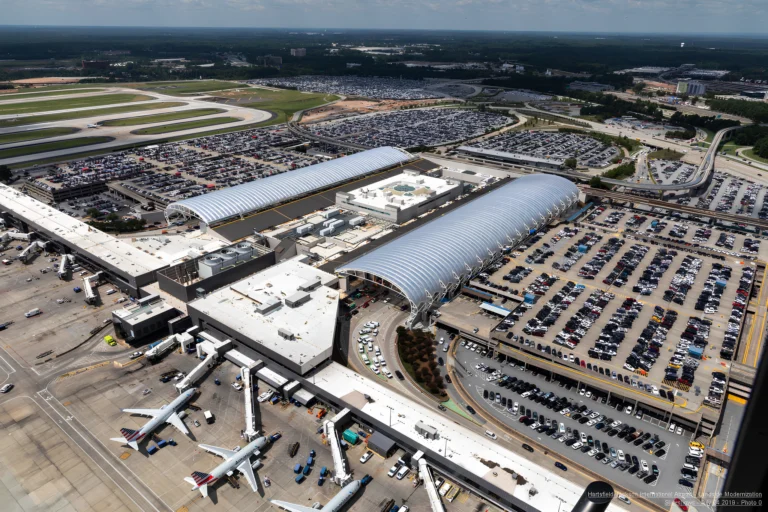Hartsfield-Jackson Atlanta International Airport is the busiest airport in the United States. In 2023, it handled approximately 104.7 million passengers, marking an increase of 11.7% from the previous year (2022). This airport has consistently ranked as the busiest in the world for many years, primarily due to its strategic location and extensive flight network. Nearly 776,000 takeoffs and landings were recorded in the same year. It has a significant economic impact on the Atlanta region, contributing approximately $34.8 billion annually.
In this article, we have covered the Top 15 busiest airports in the United States of America (USA) in detail. You will get general information about the busiest airport, its history context, passenger traffic, facilities and infrastructure, economic impact, recent developments, plans to expand or invest in infrastructure, and other important updates as well.
Table of contents
- List of Top 15 Busiest Airports in the United States
- 1) Hartsfield-Jackson Atlanta International Airport
- 2) Dallas-Fort Worth International Airport
- 3) Denver International Airport
- 4) Los Angeles International Airport
- 5) Chicago O’Hare International Airport
- 6) John F. Kennedy International Airport, New York
- 7) Orlando International Airport
- 8) Harry Reid International Airport, Las Vegas
- 9) Charlotte Douglas International Airport
- 10) Miami International Airport
- 11) Seattle-Tacoma International Airport
- 12) San Francisco International Airport
- 13) Newark Liberty International Airport
- 14) Phoenix Sky Harbor International Airport
- 15) Houston George Bush Intercontinental Airport
- FAQs about the Busiest Airports in the United States
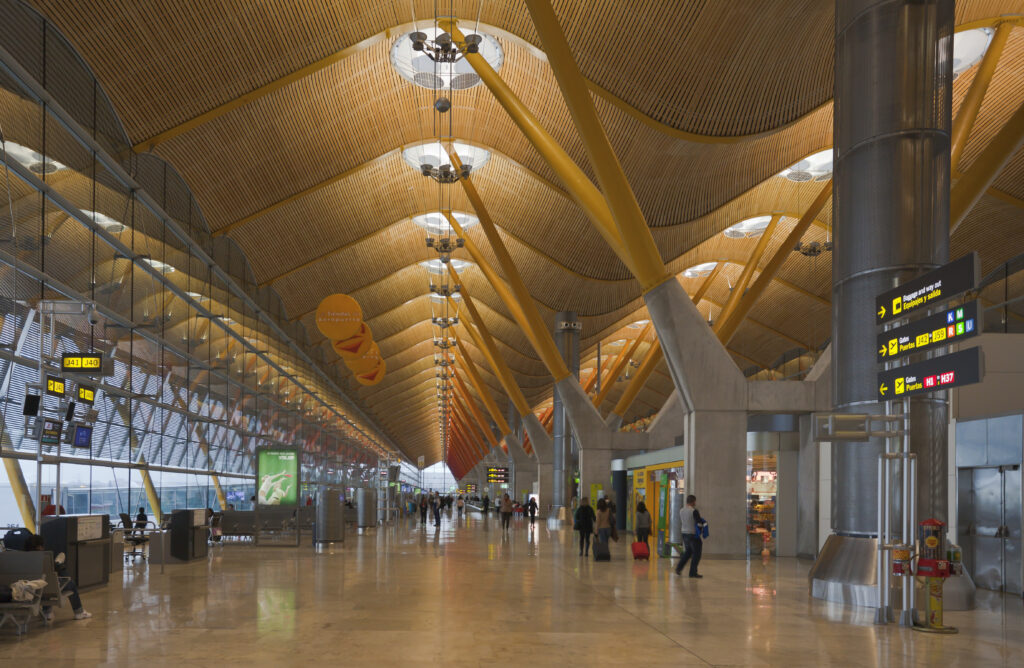
List of Top 15 Busiest Airports in the United States
Below is the list of the Top 15 Busiest Airports in the United States, this list is prepared according to the passenger count at these airports in 2023 as shared by the Federal Aviation Administration (FAA):
| S.no | Airport | Location | Passengers (Million Acc. to 2023 ) |
| 1 | Hartsfield-Jackson Atlanta International Airport | Atlanta, Georgia | 104.6 |
| 2 | Dallas/Fort Worth International Airport | Dallas, Texas | 81.7 |
| 3 | Denver International Airport | Denver, Colorado | 77.8 |
| 4 | Los Angeles International Airport | Los Angeles, California | 75.1 |
| 5 | Chicago O’Hare International Airport | Chicago, Illinois | 73.9 |
| 6 | John F. Kennedy International Airport | New York City, New York | 62.5 |
| 7 | Orlando International Airport | Orlando, Florida | 57.7 |
| 8 | Harry Reid International Airport | Las Vegas, Nevada | 57.6 |
| 9 | Charlotte Douglas International Airport | Charlotte, North Carolina | 53.4 |
| 10 | Miami International Airport | Miami, Florida | 52.3 |
| 11 | Seattle-Tacoma International Airport | Seattle, Washington | 50.9 |
| 12 | San Francisco International Airport | San Francisco, California | 50.2 |
| 13 | Newark Liberty International Airport | Newark, New Jersey | 49.1 |
| 14 | Phoenix Sky Harbor International Airport | Phoenix, Arizona | 48.8 |
| 15 | George Bush Intercontinental Airport | Houston, Texas | 46.1 |
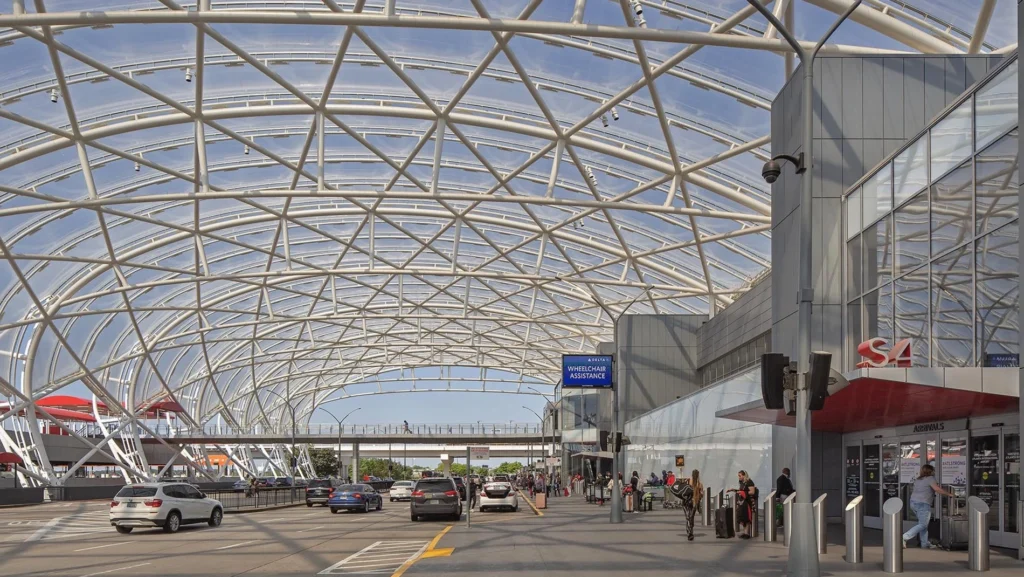
1) Hartsfield-Jackson Atlanta International Airport
Hartsfield-Jackson Atlanta International Airport (ATL) is recognized as the busiest airport in the United States and the world by passenger traffic. Here’s an overview of its key features, operations, and economic impact.
General Information :
- Location: 10 miles south of Downtown Atlanta, Georgia
- Airport Code: ATL (IATA), KATL (ICAO)
- Size: Covers 4,700 acres with five parallel runways
- Elevation: 1,026 feet (313 meters) above sea level
- Daily Operations: Over 2,100 arrivals and departures, averaging 286,000 passengers daily.
Passenger Traffic :
In 2023, Hartsfield-Jackson served approximately 104.7 million passengers, a significant increase of nearly 12% from the previous year. This growth was driven by domestic (91.8 million) and international (12.8 million) travelers. Delta Air Lines (DL) is the primary airline operating at ATL, accounting for about 75% of passenger traffic.
Historical Context :
- Busiest Airport: Hartsfield-Jackson has maintained its status as the world’s busiest airport since 1998, except for a brief period during the pandemic.
- Milestones: The airport first surpassed 100 million passengers in 2015 and has continued to grow strongly post-pandemic.
Facilities and Infrastructure :
Runways
Hartsfield-Jackson has five runways:
- Runway 9L-27R: 12,390 feet (3,776 meters) – longest runway
- Other runways range from 9,000 to 10,000 feet in length.
Terminals
The airport features a large terminal complex:
- Total Area: 156.1 acres (63.2 hectares)
- Gates: 192 gates (152 domestic and 40 international)
- Concessions: Over 263 outlets including food, retail, and services.
Cargo Operations
In addition to passenger traffic, ATL handled over 730,000 metric tons of cargo in 2022. The airport has three main cargo complexes with substantial warehouse space.

2) Dallas-Fort Worth International Airport
Dallas-Fort Worth International Airport (DFW) stands as one of the busiest airports in the United States, serving as a major hub for domestic and international travel. Here’s a comprehensive overview of its features, operations, and economic significance.
General Overview :
- Location: Situated between Dallas and Fort Worth, Texas, DFW covers an expansive area of over 26.9 square miles (17,183 acres).
- Airport Code: DFW (IATA), KDFW (ICAO)
- Annual Passengers: In 2023, DFW welcomed approximately 81.7 million passengers, solidifying its status as a vital transportation hub.
Passenger Traffic
DFW ranks as the third-busiest airport in the world for passenger traffic, following Atlanta’s Hartsfield-Jackson and Dubai International Airport. The airport’s passenger numbers have shown remarkable resilience and growth:
- 2023 Statistics: DFW served nearly 81.7 million passengers, a record for the airport, reflecting a steady recovery in air travel post-pandemic.
- Comparative Growth: This growth trajectory is particularly impressive, as it represents an increase of 8.9% from pre-pandemic levels in 2019.
- Flight Movements: The airport also recorded nearly 690,000 aircraft movements in 2023, up by 5% year-over-year.
Facilities and Infrastructure
Terminals
DFW boasts five terminals (A, B, C, D, E) with a total of 171 gates. The terminals are designed in a half-circle layout to minimize travel distance between cars and airplanes. Additionally, the DFW Skylink automated people mover system allows passengers to traverse between gates efficiently, typically taking about seven minutes.
- Terminal A: 26 gates
- Terminal B: 45 gates
- Terminal C: 29 gates
- Terminal D: 33 gates (primary international terminal)
- Terminal E: 41 gates
Runways
The airport features seven runways, with four exceeding 13,000 feet in length. This configuration enables DFW to handle a high volume of air traffic efficiently.
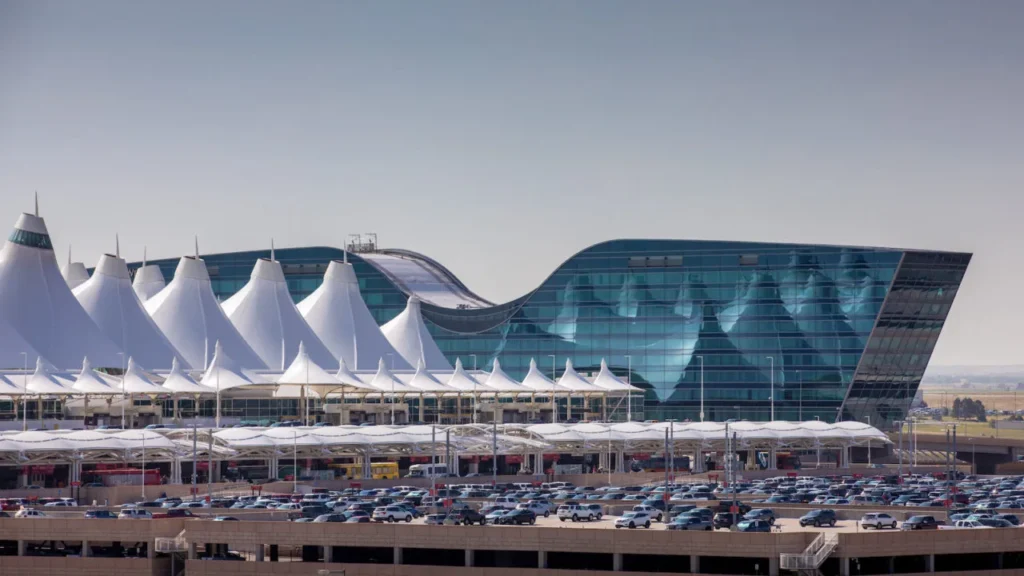
3) Denver International Airport
Denver International Airport (DEN) is recognized as the largest airport in North America by total land area and ranks as the third busiest airport in the United States. Here’s a detailed overview of its features, operations, and significance.
General Overview
- Location: Denver International Airport is located approximately 23 miles northeast of downtown Denver, Colorado.
- Airport Code: DEN (IATA), KDEN (ICAO)
- Annual Passengers: In 2023, DEN served around 77 million passengers, reflecting a robust recovery and growth in air travel.
Passenger Traffic
DEN consistently ranks among the busiest airports globally. In 2023, it recorded significant passenger traffic:
- Passenger Growth: The airport experienced an increase of about 8% compared to the previous year.
- Flight Movements: DEN handled approximately 500,000 aircraft movements, showcasing its capacity to accommodate high traffic volumes.
American Airlines serves as the dominant carrier at DEN, but many other airlines also operate numerous domestic and international flights, contributing to the airport’s diverse traffic.
Facilities and Infrastructure :
Terminals
Denver International Airport features a single main terminal, known as Jeppesen Terminal, which spans over 1.5 million square feet. The airport has three airside concourses (A, B, and C) with a total of 89 gates. This layout allows for efficient passenger flow and connectivity.
Runways
DEN boasts six runways, with the longest being Runway 16R/34L at 16,000 feet, making it the longest commercial runway in North America. This extensive runway system enables simultaneous landings and departures, reducing delays significantly.
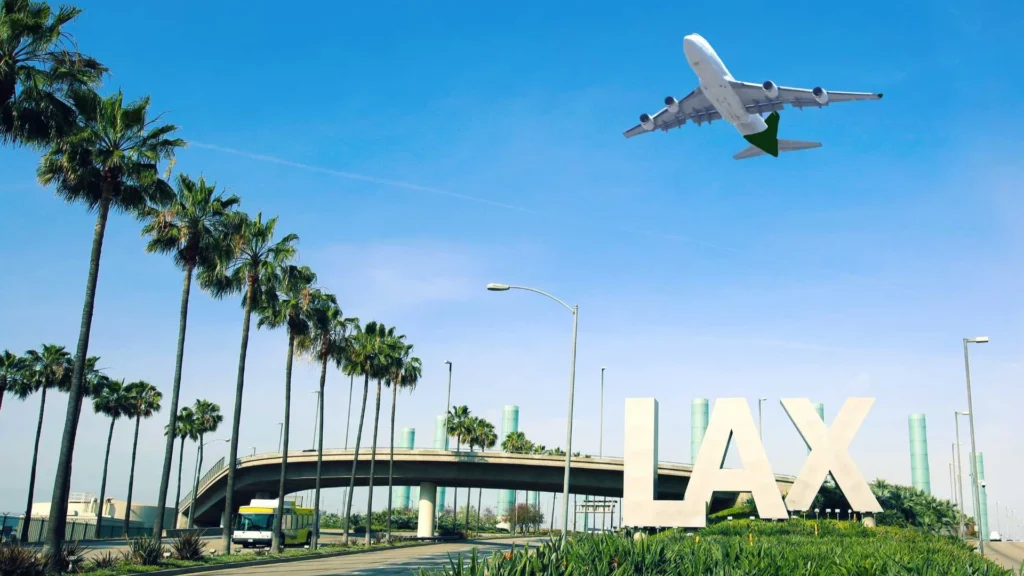
4) Los Angeles International Airport
Los Angeles International Airport (LAX) is a major global gateway and ranks as the fourth-busiest airport in the United States. Here’s a comprehensive overview of its features, operations, and significance.
General Overview :
- Location: LAX is situated in the Westchester neighborhood of Los Angeles, California, covering 3,500 acres.
- Airport Code: LAX (IATA), KLAX (ICAO)
- Annual Passengers: In 2023, LAX handled approximately 75 million passengers, making it the eighth-busiest airport in the world.
Passenger Traffic :
LAX consistently ranks among the busiest airports globally. In 2023, it recorded impressive passenger statistics:
- Passenger Growth: The airport welcomed around 75,050,875 travelers, reflecting a strong recovery from pandemic-related declines.
- International Traffic: LAX serves as a primary international gateway for travelers heading to destinations in East Asia, Southeast Asia, and beyond.
Recent Developments and Future Plans :
Looking ahead, LAX is undergoing several major projects aimed at enhancing capacity and improving passenger experience:
- Automated People Mover (APM): This project will connect terminals with parking facilities and public transport options, streamlining access to the airport.
- Terminal Modernization: Ongoing upgrades will modernize existing terminals and improve operational efficiency.
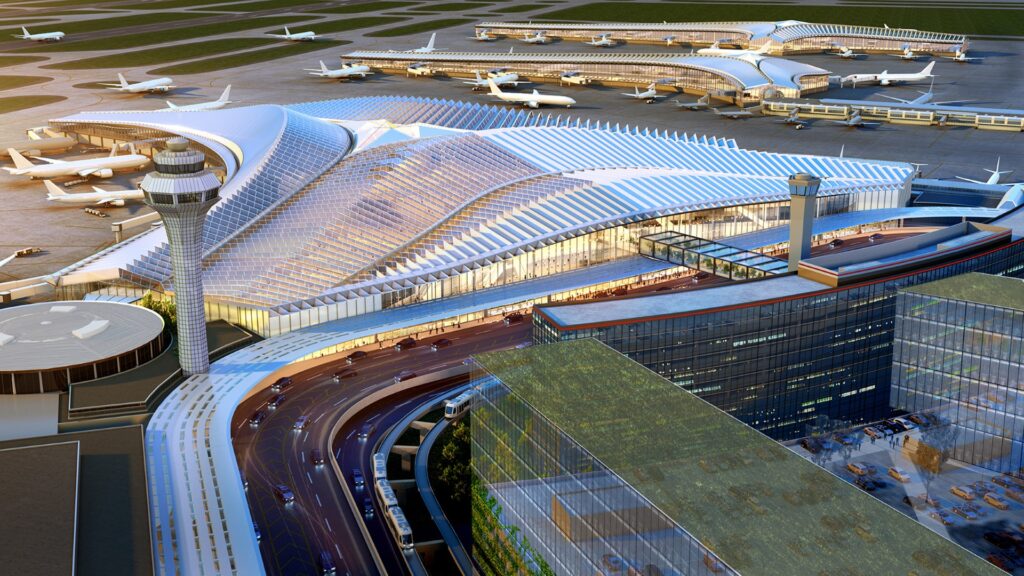
5) Chicago O’Hare International Airport
Chicago O’Hare International Airport (ORD) is a major global hub and ranks as the fifth busiest airport in the United States by total flight operations. Here’s a detailed overview of its features, operations, and significance.
General Overview :
- Location: O’Hare is located approximately 17 miles (27 km) northwest of downtown Chicago, Illinois.
- Airport Code: ORD (IATA), KORD (ICAO)
- Annual Passengers: In 2023, O’Hare served around 73 million passengers, solidifying its status as a key player in the aviation industry.
Passenger Traffic
O’Hare consistently ranks among the busiest airports worldwide. In 2023, it recorded impressive passenger statistics:
- Passenger Growth: The airport welcomed approximately 73 million travelers, reflecting a strong recovery from pandemic-related declines.
- Flight Operations: O’Hare handled over 800,000 aircraft movements, showcasing its capacity to accommodate high traffic volumes efficiently.
Economic Impact :
O’Hare significantly contributes to the local economy:
- Economic Output: The airport generates more than $45 billion annually.
- Employment: It supports approximately 400,000 jobs, both directly and indirectly.
- Visitor Spending: O’Hare accounts for around $12 billion in annual visitor spending.
Recent Developments and Future Plans
Looking ahead, O’Hare is undergoing major expansion projects aimed at enhancing capacity and improving passenger experience:
- O’Hare 21 Plan: This ambitious project includes building two new satellite concourses and expanding Terminals 2 and 5 with additional gates and amenities. The goal is to streamline operations and improve facilities for TSA and customs inspections.
- Modernization Efforts: These upgrades will enhance same-terminal transfers between international and domestic flights while providing larger landside amenities such as shopping and dining options.
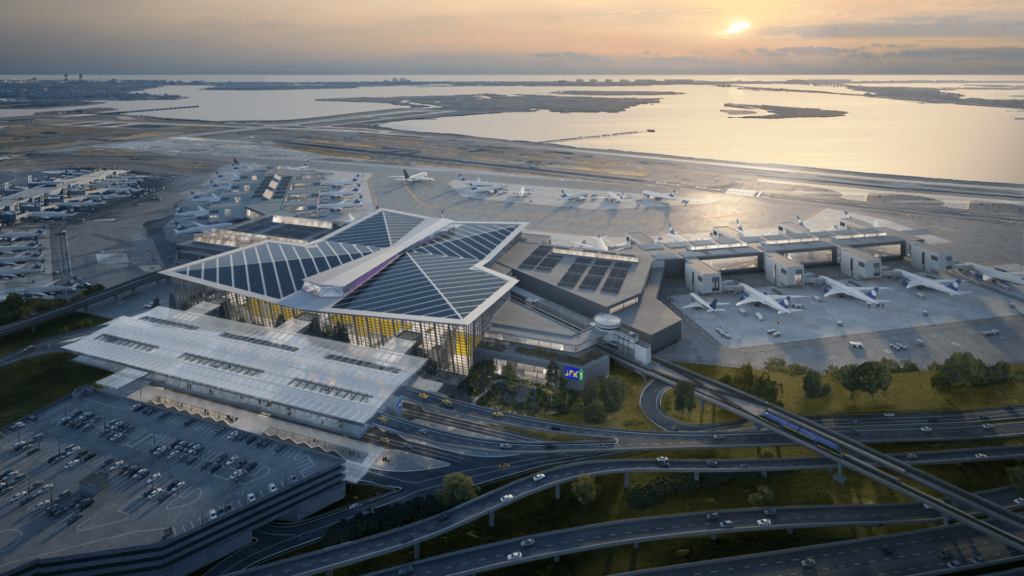
6) John F. Kennedy International Airport, New York
John F. Kennedy International Airport (JFK) serves as a major international gateway and ranks as the sixth busiest airport in the United States. Here’s a comprehensive overview of its features, operations, and significance.
General Overview :
- Location: JFK is located in the Jamaica neighborhood of Queens, New York City, approximately 16 miles (26 km) southeast of Midtown Manhattan.
- Airport Code: JFK (IATA), KJFK (ICAO)
- Annual Passengers: In 2023, JFK handled around 62 million passengers, making it a key hub for international travel.
Passenger Traffic
JFK consistently ranks among the busiest airports globally. In 2023, it recorded impressive passenger statistics:
- Passenger Growth: The airport welcomed approximately 62 million travelers, reflecting a robust recovery from pandemic-related declines.
- International Gateway: JFK is the busiest international air passenger gateway into North America, offering nonstop or direct flights to destinations on all six inhabited continents.
Economic Impact
JFK significantly contributes to the local economy:
- Economic Output: The airport generates over $37 billion annually.
- Employment: It supports approximately 256,000 jobs, both directly and indirectly.
- Visitor Spending: JFK accounts for around $9 billion in annual visitor spending.
Recent Developments and Future Plans
Looking ahead, JFK is undergoing major expansion projects aimed at enhancing capacity and improving passenger experience:
- Terminal Modernization: Ongoing renovations will upgrade existing terminals to accommodate increasing passenger volumes.
- AirTrain Expansion: Plans include extending the AirTrain system to improve access between terminals and public transportation options.
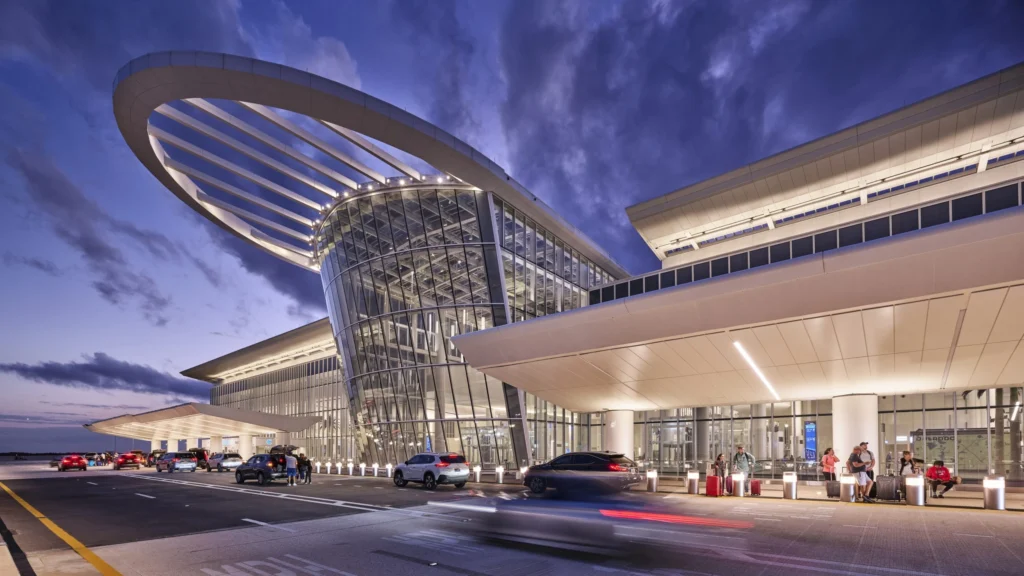
7) Orlando International Airport
Orlando International Airport (MCO) stands out as a major hub for air travel, ranking as the seventh busiest airport in the United States. Here’s a comprehensive overview of its features, operations, and significance.
General Overview :
- Location: MCO is situated approximately 6 miles (10 km) southeast of downtown Orlando, Florida.
- Airport Code: MCO (IATA), KMCO (ICAO)
- Annual Passengers: In 2023, Orlando International Airport handled around 57.7 million passengers, making it the busiest airport in Florida.
Passenger Traffic
Orlando International Airport consistently ranks among the busiest airports in the U.S. In 2023, it recorded impressive passenger statistics:
- Passenger Growth: MCO welcomed approximately 57.7 million travelers, reflecting a 15.1% increase from 2022.
- International Traffic: The airport ranked 18th for international travel traffic, with over 7 million international passengers in 2023.
Economic Impact
Orlando International Airport significantly contributes to the local economy:
- Economic Output: The airport generates over $30 billion annually.
- Employment: It supports approximately 256,000 jobs, both directly and indirectly.
- Visitor Spending: MCO accounts for around $9 billion in annual visitor spending.
Recent Developments and Future Plans
Looking ahead, MCO is undergoing major renovation projects aimed at enhancing capacity and improving passenger experience:
- Terminal Upgrades: Plans include adding eight more gates at Terminal C and renovating the original Terminal A and Terminal B buildings.
- Parking Improvements: The airport is also expanding parking facilities and implementing a new guidance system to help drivers find available spots more easily.
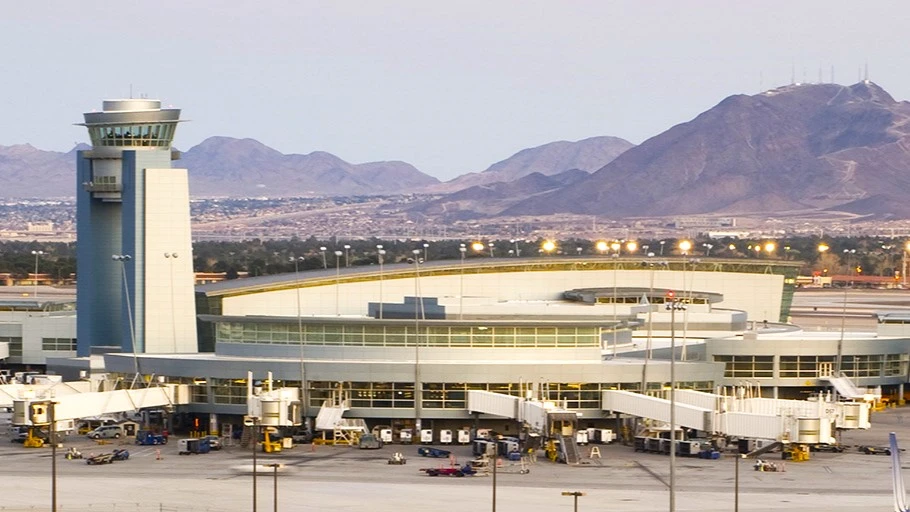
8) Harry Reid International Airport, Las Vegas
Harry Reid International Airport (LAS), formerly known as McCarran International Airport, serves as a major gateway to Las Vegas and ranks among the busiest airports in the United States. Here’s a detailed overview of its features, operations, and significance.
General Overview
- Location: Harry Reid International Airport is located approximately 5 miles (8 km) south of downtown Las Vegas, Nevada.
- Airport Code: LAS (IATA), KLAS (ICAO)
- Annual Passengers: In 2023, the airport handled around 57.6 million passengers, reflecting its importance as a travel hub.
Passenger Traffic
Harry Reid International Airport consistently ranks among the busiest airports in the U.S. In 2023, it recorded impressive passenger statistics:
- Passenger Growth: The airport welcomed approximately 57.6 million travelers, marking a significant increase from previous years.
- International Gateway: LAS serves as a key entry point for travelers heading to Las Vegas, with numerous international flights connecting visitors from around the globe.
Economic Impact
Harry Reid International Airport significantly contributes to the local economy:
- Economic Output: The airport generates over $30 billion annually.
- Employment: It supports approximately 250,000 jobs, both directly and indirectly.
- Visitor Spending: LAS accounts for around $12 billion in annual visitor spending.
Recent Developments and Future Plans
Looking ahead, Harry Reid is undergoing several major expansion projects aimed at enhancing capacity and improving passenger experience:
- Terminal Upgrades: Ongoing renovations will modernize existing terminals to accommodate increasing passenger volumes.
- Parking Improvements: The airport is expanding parking facilities to ensure convenient travel access.
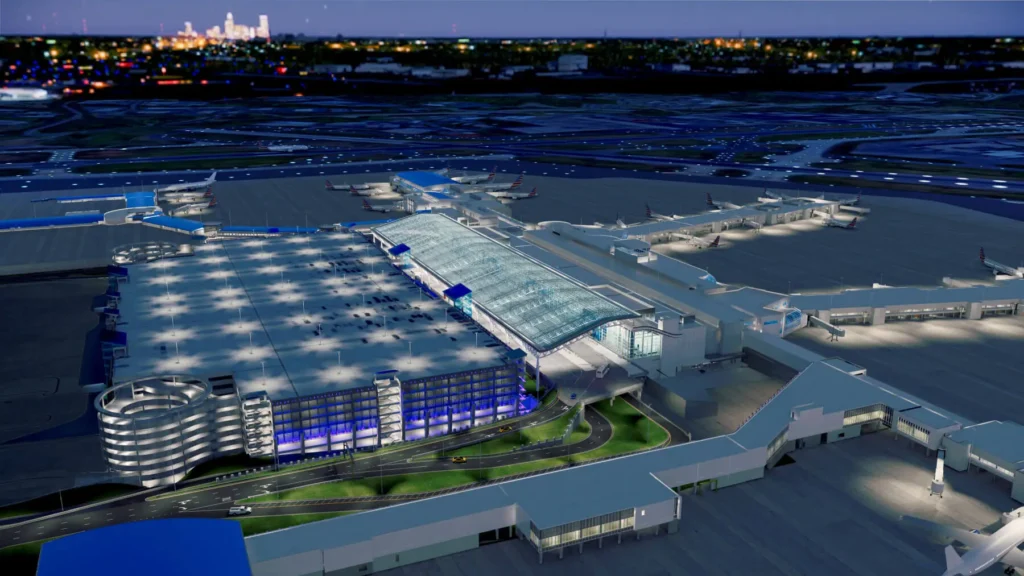
9) Charlotte Douglas International Airport
Charlotte Douglas International Airport (CLT) serves as a major hub for air travel and ranks ninth among other busiest airports in the United States. Here’s a detailed overview of its features, operations, and significance.
General Overview
- Location: CLT is approximately 8 miles (13 km) west of downtown Charlotte, North Carolina.
- Airport Code: CLT (IATA), KCLT (ICAO)
- Annual Passengers: In 2023, the airport handled around 53 million passengers, making it the sixth-busiest airport in the U.S. by passenger traffic.
Passenger Traffic
Charlotte Douglas International Airport consistently ranks among the busiest airports in the nation. In 2023, it recorded impressive passenger statistics:
- Passenger Growth: The airport welcomed approximately 53 million travelers, reflecting a steady increase in air travel demand.
- Hub for American Airlines: CLT is the second-largest hub for American Airlines, with the airline operating about 90% of flights in and out of the airport.
Economic Impact
Charlotte Douglas International Airport significantly contributes to the local economy:
- Economic Output: The airport generates over $30 billion annually.
- Employment: It supports approximately 256,000 jobs, both directly and indirectly.
- Visitor Spending: CLT accounts for around $9 billion in annual visitor spending.
Recent Developments and Future Plans
Looking ahead, CLT is undergoing several major projects aimed at enhancing capacity and improving passenger experience:
- Terminal Expansion: Ongoing renovations will add new gates to accommodate increasing passenger volumes.
- Airport Overlook: Set to open in June 2024, this new facility will offer educational displays and play areas for children while providing stunning views of aircraft operations.
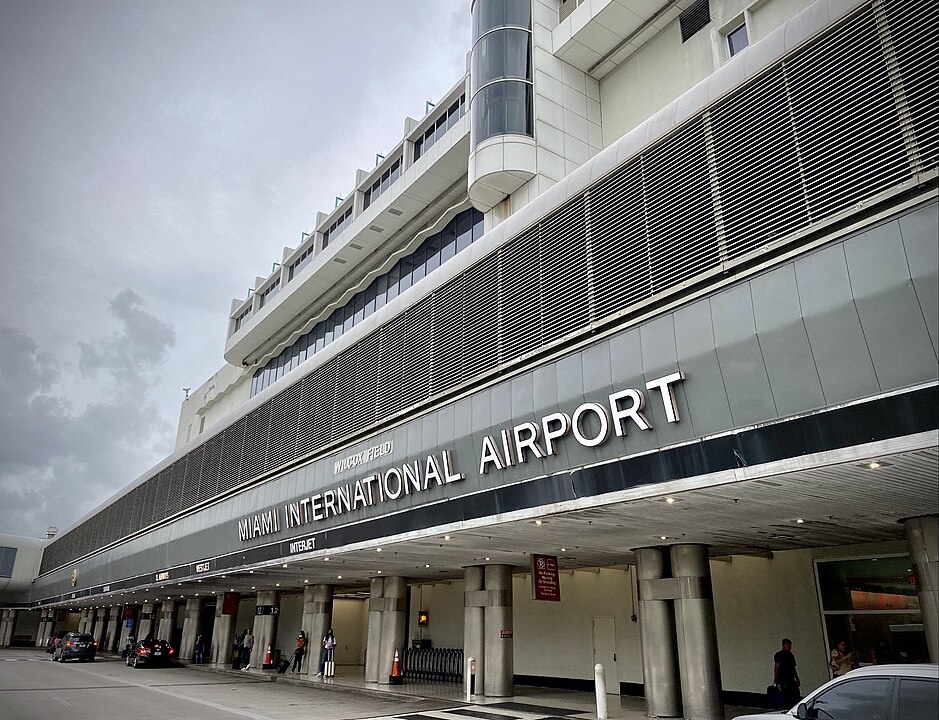
10) Miami International Airport
Miami International Airport (MIA) serves as a crucial hub for air travel and ranks 10th busiest airport in the United States. Here’s a detailed overview of its features, operations, and significance.
General Overview
- Location: MIA is located approximately 8 miles (13 km) northwest of downtown Miami, Florida.
- Airport Code: MIA (IATA), KMIA (ICAO)
- Annual Passengers: In 2023, the airport handled around 52 million passengers, making it the busiest airport in Florida and a leading gateway for international travel.
Passenger Traffic
Miami International Airport consistently ranks among the top airports in the U.S. In 2023, it recorded impressive passenger statistics:
- Passenger Growth: MIA welcomed approximately 52 million travelers, reflecting a robust recovery from pandemic-related declines.
- International Gateway: MIA is the largest gateway between the U.S. and Latin America, serving as a primary hub for American Airlines and connecting numerous international destinations.
Economic Impact
Miami International Airport significantly contributes to the local economy:
- Economic Output: The airport generates over $30 billion annually.
- Employment: It supports approximately 300,000 jobs, both directly and indirectly.
- Visitor Spending: MIA accounts for around $12 billion in annual visitor spending.
Recent Developments and Future Plans
Looking ahead, MIA is undergoing several major projects aimed at enhancing capacity and improving passenger experience:
- Terminal Upgrades: Ongoing renovations will modernize existing terminals to accommodate increasing passenger volumes.
- New Cargo Facilities: The airport is expanding its cargo handling capabilities to maintain its status as a leading cargo hub.
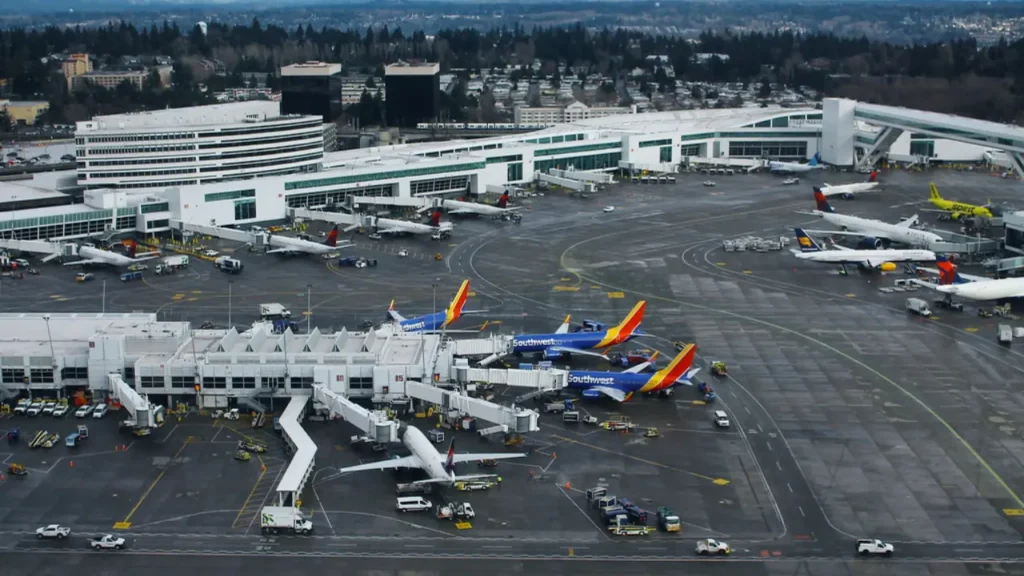
11) Seattle-Tacoma International Airport
Seattle-Tacoma International Airport (SEA) serves as a vital hub for air travel and ranks the eleventh busiest airport in the United States. Here’s a comprehensive overview of its features, operations, and significance.
General Overview
- Location: SEA is located approximately 14 miles (23 km) south of downtown Seattle, Washington.
- Airport Code: SEA (IATA), KSEA (ICAO)
- Annual Passengers: In 2023, the airport handled around 50.9 million passengers, making it the eighth-busiest airport in the U.S.
Passenger Traffic
Seattle-Tacoma International Airport consistently ranks among the top airports in the nation. In 2023, it recorded impressive passenger statistics:
- Passenger Growth: The airport welcomed approximately 50.9 million travelers, reflecting an 11% increase over 2022. Although this figure was slightly down from the 51.8 million passengers in 2019, it marked SEA’s second-busiest year ever.
- International Gateway: SEA saw over 5.8 million international passengers, achieving 101% of 2019 levels even without the full return of services to China.
Economic Impact
Seattle-Tacoma International Airport significantly contributes to the local economy:
- Economic Output: The airport generates over $30 billion annually.
- Employment: It supports approximately 200,000 jobs, both directly and indirectly.
- Visitor Spending: SEA accounts for around $8 billion in annual visitor spending.
Recent Developments and Future Plans
Looking ahead, SEA is undergoing several major projects aimed at enhancing capacity and improving passenger experience:
- Terminal Expansion: Ongoing renovations will modernize facilities to accommodate increasing passenger volumes.
- Sustainable Initiatives: The airport is implementing various sustainability measures to reduce its environmental impact while enhancing operational efficiency.

12) San Francisco International Airport
San Francisco International Airport (SFO) serves as a major gateway to the Pacific and ranks as the 12th busiest airport in the United States. Here’s a comprehensive overview of its features, operations, and significance.
General Overview
- Location: SFO is located approximately 13 miles (21 km) south of downtown San Francisco, California.
- Airport Code: SFO (IATA), KSFO (ICAO)
- Annual Passengers: In 2023, the airport handled around 50.2 million passengers, making it one of the busiest airports in the U.S. and a key hub for international travel.
Passenger Traffic
San Francisco International Airport consistently ranks among the top airports in the nation. In 2023, it recorded impressive passenger statistics:
- Passenger Growth: The airport welcomed approximately 50.2 million travelers, reflecting a steady recovery from pandemic-related declines.
- International Gateway: SFO is a leading gateway for flights to Asia and Europe, serving as a hub for several major airlines, including United Airlines and Alaska Airlines.
Economic Impact
San Francisco International Airport significantly contributes to the local economy:
- Economic Output: The airport generates over $30 billion annually.
- Employment: It supports approximately 200,000 jobs, both directly and indirectly.
- Visitor Spending: SFO accounts for around $10 billion in annual visitor spending.
Recent Developments and Future Plans
Looking ahead, SFO is undergoing several major projects aimed at enhancing capacity and improving passenger experience:
- Terminal Upgrades: Ongoing renovations will modernize existing terminals to accommodate increasing passenger volumes.
- Sustainability Initiatives: The airport is implementing various sustainability measures to reduce its environmental impact while enhancing operational efficiency.
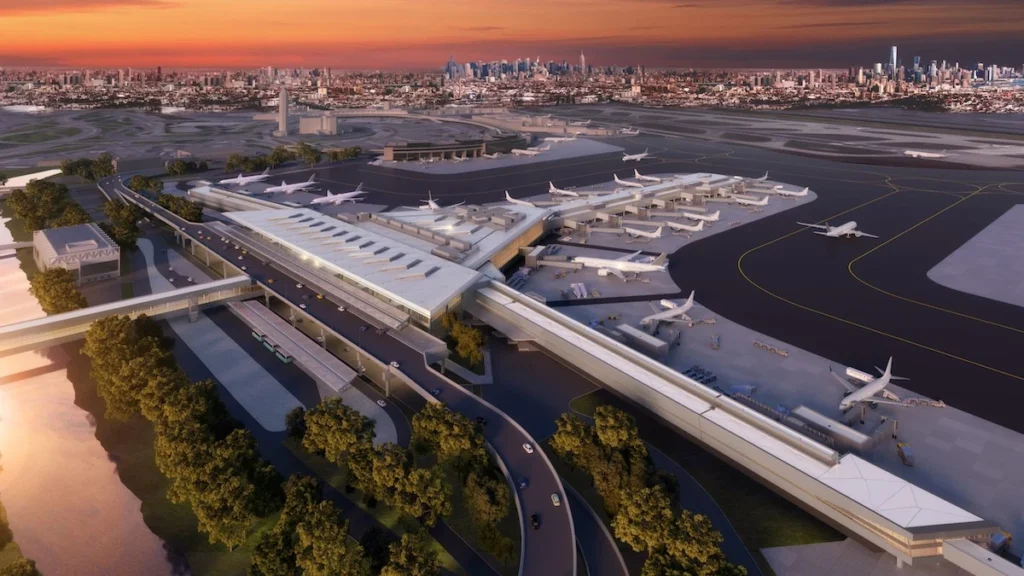
13) Newark Liberty International Airport
Newark Liberty International Airport (EWR) serves as a major hub for air travel and ranks as the thirteenth busiest airport in the United States. Here’s a comprehensive overview of its features, operations, and significance.
General Overview
- Location: EWR is located approximately 3 miles (5 km) south of downtown Newark, New Jersey, and about 9 miles (14 km) southwest of Manhattan in New York City.
- Airport Code: EWR (IATA), KEWR (ICAO)
- Annual Passengers: In 2023, the airport handled around 49.1 million passengers, making it one of the busiest airports in the U.S.
Passenger Traffic
Newark Liberty International Airport consistently ranks among the top airports in the nation. In 2023, it recorded impressive passenger statistics:
- Passenger Growth: The airport welcomed approximately 49.1 million travelers, reflecting a steady recovery from pandemic-related declines.
- International Gateway: EWR serves as a significant international gateway, particularly for flights to Europe and South America. It is also a major hub for United Airlines, which operates a substantial number of flights from the airport.
Economic Impact
Newark Liberty International Airport significantly contributes to the local economy:
- Economic Output: The airport generates over $30 billion annually.
- Employment: It supports approximately 24,000 jobs, both directly and indirectly.
- Visitor Spending: EWR accounts for around $10 billion in annual visitor spending.
Recent Developments and Future Plans
Looking ahead, EWR is undergoing several major projects aimed at enhancing capacity and improving passenger experience:
- Terminal Renovations: Ongoing upgrades will modernize existing terminals to accommodate increasing passenger volumes.
- Infrastructure Improvements: The airport is also investing in improvements to parking facilities and transportation connections to enhance accessibility.
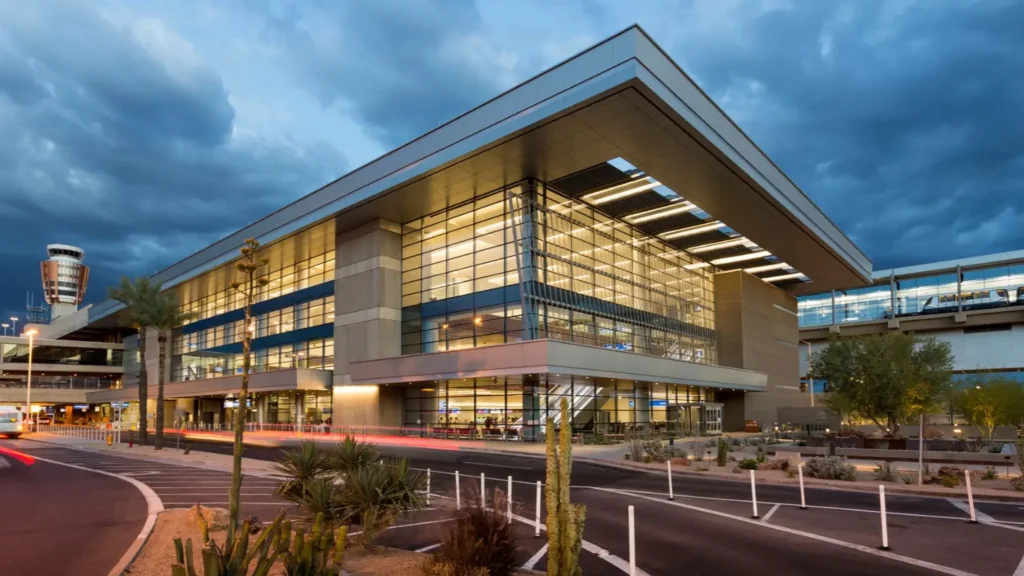
14) Phoenix Sky Harbor International Airport
Phoenix Sky Harbor International Airport (PHX) serves as a major transportation hub and ranks as the fourteenth busiest airport in the United States. Here’s a comprehensive overview of its features, operations, and significance.
General Overview
- Location: PHX is situated approximately 3 miles (5 km) east of downtown Phoenix, Arizona, making it easily accessible for both residents and visitors.
- Airport Code: PHX (IATA), KPHX (ICAO)
- Annual Passengers: In 2023, the airport handled around 48.8 million passengers, solidifying its position as a key airport in the region.
Passenger Traffic
Phoenix Sky Harbor International Airport consistently ranks among the top airports in the nation. In 2023, it recorded impressive passenger statistics:
- Passenger Growth: The airport welcomed approximately 48.8 million travelers, reflecting a robust recovery from pandemic-related declines.
- International Gateway: PHX serves as a critical gateway for flights to various domestic and international destinations. Major airlines such as American Airlines and Southwest Airlines operate extensively from this airport.
Economic Impact
Phoenix Sky Harbor International Airport significantly contributes to the local economy:
- Economic Output: The airport generates over $30 billion annually.
- Employment: It supports approximately 200,000 jobs, both directly and indirectly.
- Visitor Spending: PHX accounts for around $10 billion in annual visitor spending.
Recent Developments and Future Plans
Looking ahead, PHX is undergoing several major projects aimed at enhancing capacity and improving passenger experience:
- Terminal Upgrades: Ongoing renovations will modernize existing terminals to accommodate increasing passenger volumes.
- Sustainability Initiatives: The airport is implementing various sustainability measures to reduce its environmental impact while enhancing operational efficiency.
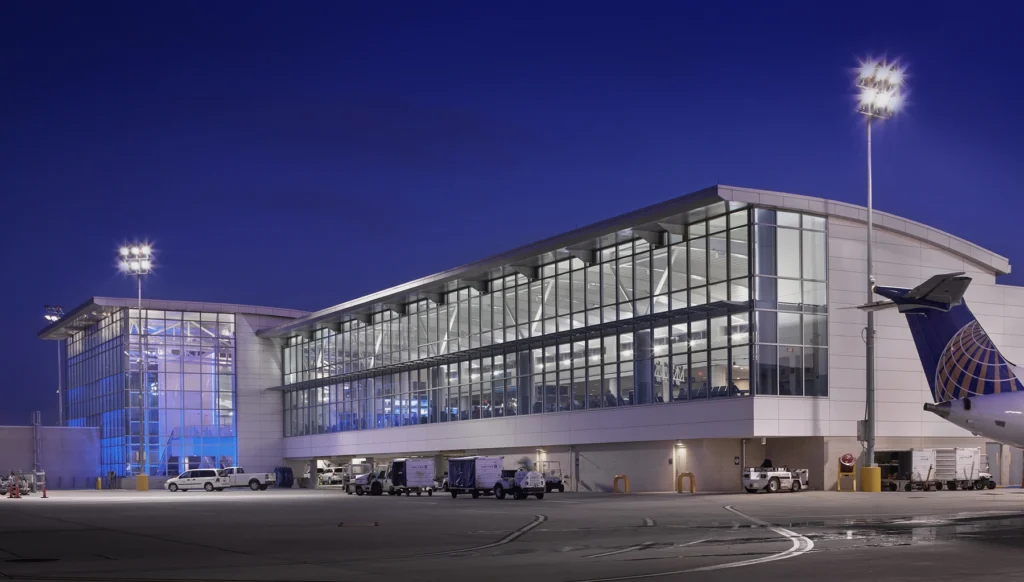
15) Houston George Bush Intercontinental Airport
George Bush Intercontinental Airport (IAH) serves as a major hub for air travel and ranks as the 15th busiest airport in the United States. Here’s a comprehensive overview of its features, operations, and significance.
General Overview
- Location: IAH is located approximately 23 miles (37 km) north of downtown Houston, Texas.
- Airport Code: IAH (IATA), KIAH (ICAO)
- Annual Passengers: In 2023, the airport handled around 46 million passengers, making it a key player in both domestic and international travel.
Passenger Traffic
George Bush Intercontinental Airport consistently ranks among the top airports in the nation. In 2023, it recorded impressive passenger statistics:
- Passenger Growth: The airport welcomed approximately 46 million travelers, reflecting a steady recovery from pandemic-related declines.
- International Gateway: IAH serves as a significant international gateway, with numerous flights to destinations in Latin America, Europe, Asia, and beyond. United Airlines operates a substantial number of flights from this airport, making it a primary hub for the airline.
Economic Impact
George Bush Intercontinental Airport significantly contributes to the local economy:
- Economic Output: The airport generates over $30 billion annually.
- Employment: It supports approximately 200,000 jobs, both directly and indirectly.
- Visitor Spending: IAH accounts for around $10 billion in annual visitor spending.
Recent Developments and Future Plans
Looking ahead, IAH is undergoing several major projects aimed at enhancing capacity and improving passenger experience:
- Terminal D Expansion: The newly expanded Terminal D-West Pier is open now, adding 160,000 square feet to accommodate growing passenger demand. This expansion includes six new gates capable of handling wide-body aircraft.
- Infrastructure Improvements: Ongoing renovations will modernize existing terminals and enhance the overall passenger experience while increasing operational efficiency.
While airports like Boston (BOS), Fort Lauderdale (FLL), and Minneapolis (MSP) are close and fly between 15-20 Million passengers annually.
For any updates and corrections in posts, please write to us at [email protected] or comment on our social media posts.

FAQs about the Busiest Airports in the United States
The busiest airport in the United States is Hartsfield-Jackson Atlanta International Airport (ATL), known for its extensive domestic and international flight options.
In 2023, Hartsfield-Jackson handled approximately 50.95 million passengers.
The top five busiest airports are:
1) Hartsfield-Jackson Atlanta International Airport (ATL)
2) Dallas/Fort Worth International Airport (DFW)
3) Denver International Airport (DEN)
4) Chicago O’Hare International Airport (ORD)
5) Los Angeles International Airport (LAX)
Dallas/Fort Worth International Airport (DFW) serves as a major hub for American Airlines.
Denver International Airport (DEN) is known for its expansive size and unique architecture, serving as a major transfer point for domestic and international flights.
John F. Kennedy International Airport (JFK) is a leading international gateway, ranking high in passenger traffic and serving numerous global destinations.
Harry Reid International Airport (LAS) serves as the primary airport for Las Vegas, accommodating a large number of tourists.
Miami International Airport (MIA) is a significant gateway to Latin America, offering extensive international flight options.
Travelers can expect various amenities, including dining options, shopping, lounges, and art installations at most major airports.
These airports significantly contribute to their local economies by generating billions in economic output and supporting hundreds of thousands of jobs.
Stay tuned with us. Further, follow us on social media for the latest updates.
Join us on Telegram Group for the Latest Aviation Updates. Subsequently, follow us on Google News

